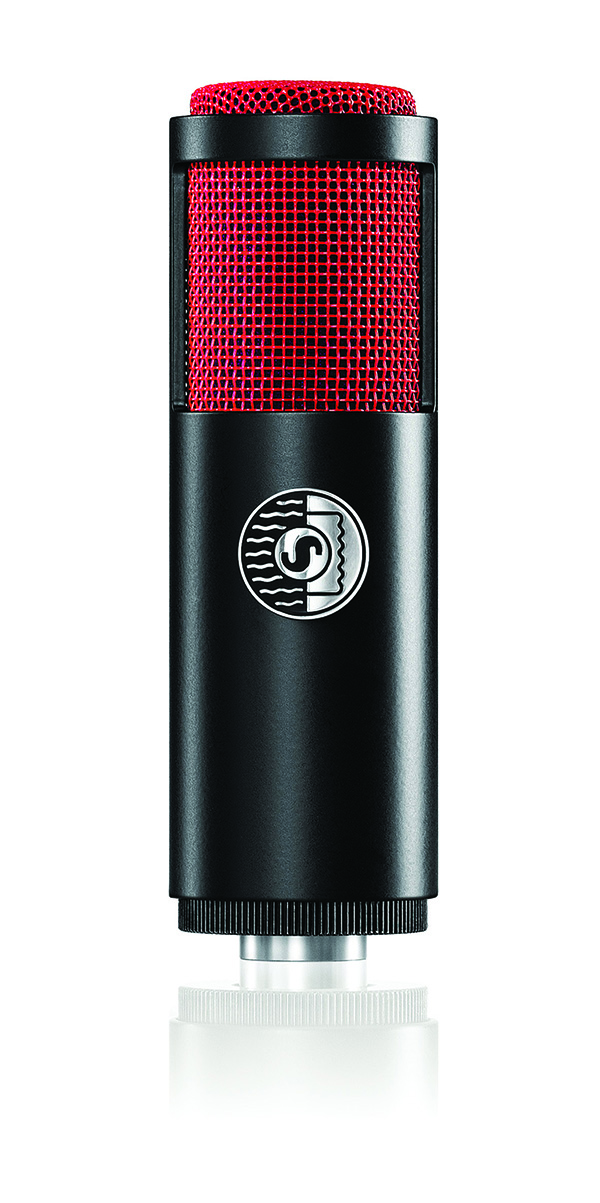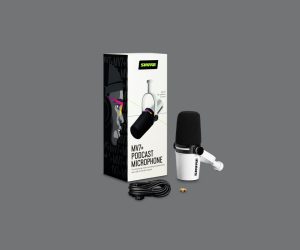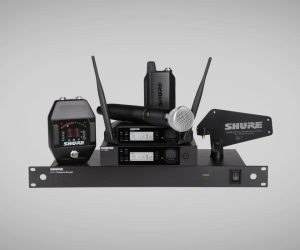
SHURE KSM313 & KSM353

Are these ribbon mics from Shure really made out of recycled parts from an alien spacecraft?
Text: Greg Walker
When Shure took over boutique US ribbon microphone manufacturer Crowley & Tripp earlier this year there was mixed reaction in the audio community. Some bemoaned the takeover of yet another small independent manufacturer by a bigger company, while gear hounds worldwide looked for the drop in prices that Shure would likely bring about thanks to the company’s improved economies of scale. While Shure discontinued most of the C&T product line after the takeover, it kept two of the best designs in production: Crowley & Tripp’s ‘El Diablo’ and ‘Naked Eye’ models. These are now back on the market as Shure KSM313 and KSM353 ribbon microphones.
THE DEVIL YOU KNOW
The diminutive KSM313 is a devilishly eye-catching number indeed. With its bright red grille and heavy-duty gloss-black casing it reminds me of an angry little wasp perched on its unusual ‘monocle’ mount. The 313 is 13.5cm tall and 4.3cm in diameter, making it one of the smallest ribbons I’ve had the pleasure of using. As if to make up for its small stature the 313 is surprisingly heavy at 400 grams and the build quality is exceptionally good. The thickness of the casing alone inspires confidence and while I prefer the ‘Star Trek’ badge of the original C&T model, the small stylised Shure badge on the front and the overall physical presence of the mic give it some real personality. However, I can’t say I’m a big fan of the ‘monocle’ mount. It’s a fiddly affair that’s stylish to look at but tricky to work, mainly because the tightening ring at the bottom is impossible to properly access once it’s more than three quarters screwed into the mount. I found myself having to twist the microphone itself to try and tighten the ring sufficiently, which meant precise positioning was a bit of a pain. The other more serious issue with the review model was that the monocle arm – a strip of thick metal that is clearly supposed to have a 90-degree twist in it – was only twisted about 80-degree. So the KSM313 spent its entire time in my studio leaning a little to the right – hopefully this was just a defect in the demo model rather than a sign of things to come. A more conventional shock mount is also available for the 313 and is probably a better bet regardless.
Gripes aside, under the fancy exterior lies a little beast of a ribbon with plenty to offer. The published frequency response is 30Hz to 15kHz and the output is transformer balanced, but most notably the KSM313 ribbon element is made from ‘Roswellite’. This is the mysterious new alloy (presumably made from genuine recycled Roswell UFO material) originally developed and patented by Crowley & Tripp. The company was in the process of retrofitting the new ribbon elements to its entire range when Shure took over, and this was presumably one of the things that attracted Shure’s interest in the first place.
The Roswellite ribbon element is a patented composite material that’s much more durable and elastic than conventional aluminium foil ribbons. This means the mic can withstand higher sound pressure levels and is far less delicate in general use than the vast majority of new and vintage equivalents. Shure claims the Roswellite material has superior high tensile strength and ‘shape memory’, making it perhaps the first truly gigable ribbon to hit the market! With its small footprint and published spec of 146dB SPL the KSM313 could be legitimately considered for live applications – where ribbons have traditionally feared to tread – albeit with a band that doesn’t like to trash its gear.
Another cool feature of the 313 is its ‘dual-voice’ motor assembly, with the front lobe biased for a warm, full-bodied response and the rear lobe delivering more top-end presence and a reduced proximity effect, making it more suitable for vocals and close-mic’d acoustic instruments. As far as frequency response is concerned, the front lobe is pretty much flat up to around 4kHz where a small presence boost kicks in. Above 6kHz the response gently falls away to be down 7dB at 10kHz. The rear lobe has a similar presence lift around 4kHz but is much more even
up to 10kHz, providing the extra presence available on
this side of the mic.
CORVETTE VS ROLLER
If the KSM313 is the little red Corvette of ribbon microphones then the KSM353 is most certainly a Rolls Royce. This thing weighs 633 grams and is built like a tank. You can’t help but be impressed by it when you pick it up. It’s a decent sized mic at almost 16cm tall and 4.8cm in diameter, with a fashionably thick silver casing that’s streamlined and elegant. The KSM353 shares many of the 313’s key features: a Roswellite ribbon element, transformer-balanced output and a published SPL rating of 146dB. The 353 exhibits no tonal difference between front and back lobes, and the review model also came with a more conventional spring-loaded suspension mount. This initially seemed a little lightweight for the task of holding an expensive and weighty microphone in position, but I soon got used to it and it ultimately did a very good job of keeping the 353 safely aloft. The KSM353’s frequency response chart shows a gentle roll-off below 100Hz, small bumps around 100 and 116Hz and a couple of larger rises around 4 and 10kHz, with a slight notch
around the 8kHz mark. We’re only talking ±3dB at most
here so the sonic image this microphone captures is relatively flat.
SONIC IMPRESSIONS
So how do they sound? Well, I worked them pretty hard while they were in my studio and I certainly wasn’t disappointed. I loved the KSM313 on acoustic guitar where it gave a truthful yet slightly flattering picture of hard picked strumming, and it really shone on more intimate finger picked parts. I did a shootout between the two mics on a reasonably loud electric guitar and loved the tone both mics captured. The 313 seemed to pick up more of the room sound, amp reverb and some of the overtones from the amp whereas the 353 seemed to capture the essence of the sound and really pull it together. Whenever I placed the mics side-by-side this seemed to happen. The 313 was great for capturing a sound along with its ambience and the 353 seemed to grab each sound by the throat and give you ‘essence’, almost as though the sound had undergone some subtle and well-judged processing between mic and recorder to sort the wheat from the chaff. This certainly marks the 353 out as special in my book and the mic is a real star in most applications.
On vocals both mics performed beautifully, being present enough not to sound dull or muddy while still having a characteristically ribbon-like quality, and of course the 313 provides the added advantage of two tonal options to better match the tone of the vocalist. The Shures were also great as room mics on a drumkit and seemed to ‘read’ the room well, delivering low-mid energy that made a slightly flat close-mic’d drum sound come to life. Finally, I took advantage of the Roswellite ribbon’s high SPL tolerance and jammed both mics about six inches in front of a kick drum, and while both sounded good in that role, the 353 won the shootout by a micron thanks to its capture of a slightly more powerful, well-rounded image.
So what’s not to like? Well, my only other gripe was the surprisingly low output of both mics – I had to crank both input and output knobs to 10 on my UA2108 mic pres to get a decent signal on quieter sources and this surprised me somewhat coming from a modern ribbon design. Suffice it to say you’ll need high output, low-noise preamps to get the best out of the Roswellite elements. This is by no means a deal-breaker though as even low-level signals out of these mics sound great and in general use these are almost certainly the most versatile ribbon mics I’ve used. The small footprint of the KSM313 and its dual voice element make it a very useful tool while the KSM353 has the extra sonic quality to take a recording to the next level. While it’s a shame to see the Crowley & Tripp name disappear, it’s a good thing that some portion of its legacy continues. These new Shure mics are well worth a look if you’re in the market for a ribbon with great tone and a few new tricks up its sleeve.
















RESPONSES